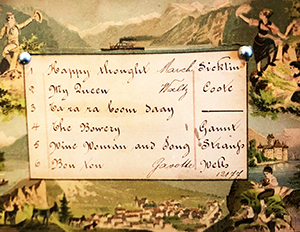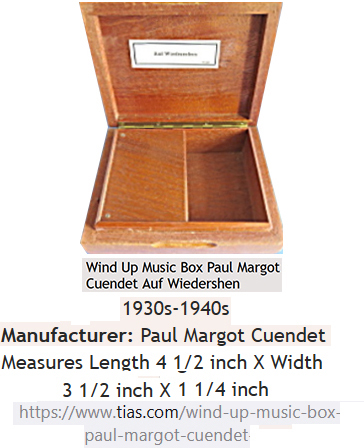|
The CUENDETS (1818 – 1980er Jahre) John & Edouard Cuendet (JEC-Rundlogo) Abraham-Louis Cuendet (1818–1850) “The origin of our music boxes goes back to Abraham-Louis Cuendet, who secretly contacted the Lecoultre brothers in Bas-du-Chenit and Justice of the peace Piguet of Le Lieu.” (Favre 1865) “It is more than likely that Abraham-Louis Cuendet reaped the benefit of this course of action; that he went to the Vallée de Joux, where the production of music boxes was advancing with giant strides; and that he met the Lecoultre brothers and Piguet in Le Lieu.” “He was assigned an apartment in the Halles building in Sainte-Croix, where the authorities had put one floor at the disposal of craftsmen, at modest prices. He even asked for additional space in 1814, so he could work there with Samuel Cuendet, called ‘L´Anglais’ (‘the Englishman’). He paid fifty francs per annum for his accomodations in 1818.” “Im March 1811, he became father of a little girl, of a son the following year, and of another daughter in 1814. He was young and no doubt motivated by the need to feed a young family. It is therefore possible that the first music box made in Sainte-Croix came from his workshop, which then became the Town Hall and which is today being restored by private initiative.” (Piguet) Cuendet, Abraham-Louis, Switzerland. Maker of musical boxes c. 1810. (Ord-Hume, Musical Boxes, p. 299) Cuendet, Abraham-Louis, Switzerland, about 1810, maker of musical mechanism. (Mosoriak p. 76-77) Charles Huguenin “In 1818, Abraham-Louis Cuendet survived the famine and carried on with his établisseur activity, in cooperation with Charles Huguenin of Sainte-Sulpice.” Emile L. Cuendet (=E. L. Cuendet), (1854 – 1952) Cuendet, Emile, Hoboken, N. J., U. S. Patent 363,451, May 24, 1887. (Mosoriak p. 76-77) Cuendet, Emile L., (citizen of Switzerland) Brooklyn and New York, N. Y., U. S. Patent 501,766, July 18, 1893. Co-patentee: 577,839, march 2, 1897. (Mosoriak p. 76-77 [erroneously two entries]) 1887: music-box-related patent (Piguet, Music Box Makers, 2004, p. 48) 1890s:
music-box-related patent (Piguet, Music Box Makers, 2004, p. 40) Cuendet, Émile L. Born in 1858 at Ste-Croix, Switzerland, he worked for C. H. Jacot and subsequently went with them to America where they held the Mermod Frères agency. He became foreman for the company in 1893 and began evolving new designs. By 1886 he was established at 21 John Street, New York, and ten years later became president of the American Musical Company of Hoboken. Here he produced the Monarch disc musical box, followed by the Triumph. He was advertising the Monarch from his John Street adress in 1896: `All styles from $8 to $400. Tunes 25 cents each.´ He died in 1952 aged ninety-four. He was a master at making overture boxes. (Ord-Hume, Musical Boxes, p. 299)
Music boxes ELC (=Emile L. Cuendet) ( Eugène Cuendet “At the beginning oft he thirties, Abraham-Louis Cuendet's son Eugène Cuendet, after finishing his apprenticeship, emigrated to New York where he distributed the watches and music boxes made by his father.” “In 1831, Cuendet was one of the six “music box and watch traders”, registered by the municipality and in 1833, he was the first local manufacturer to subject his products to outside competition. It was at the first Exhibition of Swiss Industrial Products in Lausanne that he presented ‘a large music box playing six tunes, with a solid comb, for the price of 88 £, as well as two smaller muxic boxes with two tunes, in the form of rectangular snuffboxes, at a price of 10 £ each’.” “Abraham-Luis Cuendet gave up his industrial activity around 1850.” Zu einer Abbildung der Unterschrift von A.-L. Cuendet; TMB 18, 5, 1998, p. 136, Nr. 10 (Compare Piguet, Faiseurs, (1996), p. 288-289, see Piguet, Music Box Makers, 2004, p. 60 and 209; Bellamy, Music Makers of Switzerland, (2015), p. 6) Cuendet-Develay Cuendet-Develay Frères, “In the 1850s, Philippe Cuendet of Sainte-Croix earned a living working the land, and probably also doing odd jobs in the watchmaking and music box field. He married a Develay girl who supplemented the family income by giving lessons.” “Together with his sons Charles and Samuel, Philippe Cuendet created Cuendet-Develay Frères at the end of the 1870s and participated in the Exhibition of Machines and Tools used in the Watchmaking Sector in May 1880 in Geneva.” (Only watches where exhibited, no music boxes.} He went to the World Exhibition in Amsterdam in 1883 all alone, Switzerland not represented on account of the National Exhibition in Zurich. He saved the day for music boxes because he was awarded a silver medal, together with Langdorf of Geneva.” Bellamy, Music Makers of Switzerland, (2015), p. 6: “Cuendet-Develay late 1870's” Cuendet-Develay, Fils, et Cie. Switzerland. Makers of musical boxes c. 1891. In that year they devised a method of damping the teeth of a cylinder box comb by using a fork-shaped damper mounted upright below the tooth. They produced a musical box employing these patents and which played cylinders pinned to perform only one tune. The pins were like small nails and the idea was rugged durability, simplicity and cheapness of production. For the fortunate owner of the box, each new tune meant a new cylinder to buy, the only consolation being the wording of the label under the lid in place of a tune sheet which proclaimed `Patent Undestroyable [sic] Dampers´. A late version of this box could play cylinders each having three tunes. (Ord-Hume, Musical Boxes, p. 299) “In the same year [1883] the partnership was dissolved and immediately reregistered under the name Cuendet-Develay Fils Cie. with the same persons, with the objective of producing watches and music boxes. Five years later [1888], following the withdrawal of Philippe, the company was again dissolved and then reinstated on 1st January 1888, as Cuendet-Develay Fils & Cie (Charles and Samuel Cuendet, 1st January 1888 – ?) with Charles and Samuel Cuendet, under the name Cuendet-Develay Fils & Cie., but they no longer dealt with watchmaking. The company employed eight workers in Sainte-Croix.” Cuendet, Samuel, Ste. Croix, U. S. Patent 474, 520, May 10, 1892. Switzerland Patent 3,426, Feb. 18, 1891. Both assigned to Cuendet, Develay Fils & Co., Ste. Croix, Switzerland. (Mosoriak p. 76-77) “Universelle”® “That was the time when competition from the disc music boxes from Germany first appeared. The low cost of the spare discs and their easy interchangeability were a definite advantage. The company tried to find a way out by developing a cylinder music box, which met with success. This was called the Universelle, which, as its name suggested, made cylinder change easy for everybody. It also proved to be very strong, resisting all kinds of climate and manipulations, even the least delicate. The dampers were fitted in such a way that they could be declared indestructible, the pins were of a given length to reduce the teeth tips in order to prevent damage during cylinder change. In 1891, the music box Universelle was patented in all the relevant countries in the name of Cuendet-Develay. It had cylinders playing only one melody, at very competitive prices. Thus the manufacturer suceeded in reconciling the imperatives of the lowest possible cost price – to the extent that the Univeselle, a simple and solid product, lent itself readily to mass production, - with the imperatives of attractive sales prices. This allowed consumers to be constantly up to date when buying a cylinder box with the latest melody from their “usual music box dealer. Most of the Universelle pieces were supplied with three tuned bells, sometimes with drums and other noisy attachments. The boxes were well built but straightforward and came with a notice detailing the merits of the Universelle and the instructions for use. The cylinders were made from a very thin sheet of zinc, one layer of cement to hold the pins, also made of zinc. This presented the risk of deformation, with a negative influence on musical quality. Most of the tunes came from the operetta and music-hall repertoires and also some popular English songs. (Larry Karp in MBSI, Journal of Mechanical Music, autumn 1995, pages 30-33)” Cuendet-Seeger “However, all the advantages of the Universelle faded into insignificance next to those of the ever more popular disc-playing boxes. Sales apparently did not come up to expectations. Therefore, in 1894, Samuel Cuendet decided to retire and so the company was dissolved and replaced by a new one, called Cuendet-Seeger, under the responsibility of Charles Cuendet-Seeger. It was to last five years, until 24th November 1899, when the latter withdrew, having meanwhile become involved in a business which would develop rapidly.” Joined up with B. H. Abrahams, own factory in St. Croix since 1895, manager: Charles Cuendet-Seeger “In fact, Cuendet-Seeger had meanwhile joined up with the Englischman Barnett H. Abrahams, who had a musical instrument shop in London, had a lot of experience in music box sales and had the necessary capital. The latter decided to open his own factory on 2nd September 1895, at No 3, Rue des Arts in Sainte-Croix and announced in the local press that he had appointed Charles Cuendet as manager, bringing with him the know-how of Cuendet-Develay.” (Compare Piguet, Faiseurs, (1996), p. 289-290, see Piguet, Music Box Makers, 2004, p. 60 and 209-210, TMB 18, 5, 1998, p. 136, Nr. 11) Samuel Cuendet-Bachmann, called “L´Anglais” (“the Englishman”, 1895 –1898) “Samuel and Charles Cuendet, who were brothers, had been working together in music box production since 1883 and continued to do so until 1894 when their company Cuendet-Develay Fils was dissolved and taken over by Barnett H. Abrahams.” “The two brothers went their own ways: Charles set up a company in his own name and then took over the management of the BHA = Barnett Henry Abrahams factory, [see above], whereas Samuel Cuendet-Bachmann produced music boxes for a few years, without officially registering his company.” “On 27th July 1895, he “is looking for pinners, fitters and assemblers for the two-tune boxes”, then a competent handcrank fitter on 16th May 1896, and on 14th November he has work for pinners and assemblers for the two-tune 50-note pieces, a young boy to run errands between school hours, as well as a young worker, preferably somebody doing assembly work ’.” “On 12th March 1898, Cuendet-Bachmann announced that ‘non-unionized workers are invited to contact the undersigned, who will give them preferential treatment’, which showed that he did not appreciate attempts on the part of the workers and the majority of manufacturers to regulate music box prices and work wages. He may even have been the author of the following advertisement published in the same edition oft he local newspaper: ‘A music box factory is for sale on account of the untenable position created by the trade union’. There is no further trace of the company.” (Compare Piguet, Faiseurs, (1996), p. 290, see Piguet, Music Box Makers, 2004, p. 60 and 210-211) Philippe Cuendet (*1868, établisseur, 1895: assembling own products; officially registered 1916 – 1824) “Philippe Cuendet was born in the Prise-Perrier, near L´Auberson, on 27th April 1868. He tended the land of his father, Constant, and learnt the music-box-related trades with the local établisseurs until he felt capable of assembling his own products in 1895. Philippe Cuendet ordered his boxes from Auguste Jaqués and gradually became familiar with the world of the établisseurs, without ever going as far as to officially create his own company.” “At the turn of the century he took over the production and all the arrangements of the Emile Bornand-Wenger company, which was set up in Geneva in 1902.” “Philippe Cuendet carried on his production of musical movements and introduced his large family to the business, which was organized entirely on the farm, alternating with farming work. In L´Auberson, where he had settled after his marriage, he was more or less indifferent to the problems of Sainte-Croix. Manufacturers were struggling with sales prices for musical alarm clocks and signed an agreement in 1910 in which they undertook to charge fair prices. Cuendet abided by the terms of the agreement, but gave warning a few months later that he could no longer do so, which created some commotion beyond the village borders. The problem was well nigh impossible to solve: the manufacturers signed agreements related to sales prices for the twenty-eight-note movements of the same type, with an inferior number of teeth which they of course sold for less. They could therefore ensure orders as long as their competition had not developed a similar model. Philippe Cuendet just could not keep up with the rest.” Click here to see a Music box by Philippe Cuendet (Compare Piguet, Faiseurs, (1996), p. 290-291, see Piguet, Music Box Makers, 2004, p. 60 and 211-212) From Philippe to John Cuendet“During the war, the établisseurs managed to survive by manufacturing music boxes and taking on all sorts of metalwork. Of his ten children, John and Edouard were particularly interested in this type of activity. After spending a year in the German part of Switzerland, John returned to L´Auberson.” “Even though Philippe Cuendet only registered his company on 6th June 1916 – he had been making music boxes for over twenty years! It was definitely his son John who managed his affairs and who took over eight years later, on 30th May 1924, under the name John Cuendet [1/2], manufacturer of musical movements for albums, and all kind of toys, movements for alarm clocks [...] (1924 – 1935) Cuendet, John E. Auberson, Switzerland. In 1870 was making musical boxes. Most likely the grandson of Abraham Louis and brother of Émile. The Cuendet factory still makes small musical movements. (Ord-Hume, Musical Boxes, p. 300) Cooperation with Francis Martin, „who managed to keep up music box sales, for a reasonable commission, well into the years of economic crisis.” (Piguet 2004, p. 257) “John-E. Cuendet, manufacturer of musical movements for albums, and all kind of toys, movements for alarm clocks, lighter wheels”, a trade name which he simplified in 1935 to John Cuendet [2/2], manufacturer of all types of musical movements (1935 –?) Perhaps a mouvement, stamped JC Edouard Cuendet, manufacturer of all types of musical movements (1935 –1940s) “As for Edouard Cuendet, he set up a workshop to make speed governor assemblies, which he sold to his brother [John]. The whole family was involved in music boxes, each according to his specific talent, and on the basis of everyday experience where family, land and music boxes provided the means of material existence. Vacation was not an issue, perhaps not even tought of “People were very happy”, said Nelly Martin-Cuendet. Her life was different to that of the women working in factories in Sainte-Croix, bound by industrial discipline, better paid but also spending more, threatening by unemployment in times of economic crisis.” “John [and] Edouard Cuendet´s company only made musical movements and for this reason he did not participate in fairs or exhibitions, except for the National Exhibition in Zurich in 1939, where he accompanied six other local manufacturers. His products went to manufacturers of toys, souvenirs and other novelties, who sold them again as finished products. In the thirties, he had clients as fas as Germany, Austria, the United States, Yugoslavia, some Swiss tourist resorts and especially France.” “Cuendet sold movements to Paris, where they were incorporated into all sorts of useful and amusing objects, sometimes even some naughty ones” “In Lourdes, he supplied movements playing the Ave Maria, much appreciated by the pilgrims. This market was of vital importance during the critical years. It represented sixty-five percent of the 1931 turnover and eighty-five precent in 1934, at the height of economic depression. Those were difficult times, requiring absolute managerial discipline, like in 1934, for example, when consignments for Lourdes were paid only once a year” See “John Cuendet personally knew Blanchard and Laurent, agents for a shop in Lourdes. They sometimes came to L´Auberson and then every manufacturer tried to obtain their order. They appreciated the Cuendet movements for their meticulous finish and especially for the quality of their arrangements, which were becoming more an more popular. In fact, these movements were highly regarded far and wide for their musical qualities, considering their small size, wether it be in popular songs or extracts from Haydn or Mozart.” John & Edouard Cuendet (1940s–1992)
1940s: partnership of the two brothers John and Edourd “The rapid development of the company encouraged the Cuendet brothers to put up a building in L´Auberson, on the way to Les Grangettes. 1960s: 15 employees. In the sixties, there were about fifteen people working in the mechanical workshop, in packing etc., and about the same number of home workers for cylinder-tuning and music box assembly. Products ranged from single-tune eighteen-note movements up to four-tune fifty-note movements, for various destinations.” 1964: John Cuendet†. “In October 1964, an article appeared in a Musical Box Society International publication paying tribute to John Cuendet, manufacturer and arranger, who died on 17th July 1964, and who knew so well how to render the true spirit of dance music.” “The management of the company was left to his brother Edouard and his two daughters, Renée, wife of Frank Joseph, and Frida, wife of Ami Jaccard, who both worked for the company, assisted by their respective husbands. After the death of Edouard Cuendet on 4th January 1972, his daughter Susy, wife of Jean-Paul Chollet, who ran the mechanical workshop, became a partner to their two cousins.”
|
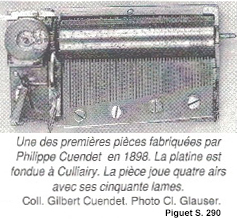

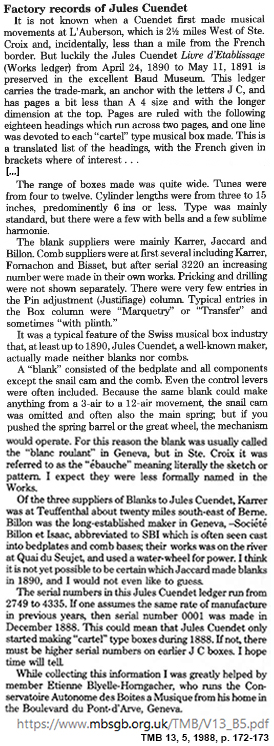

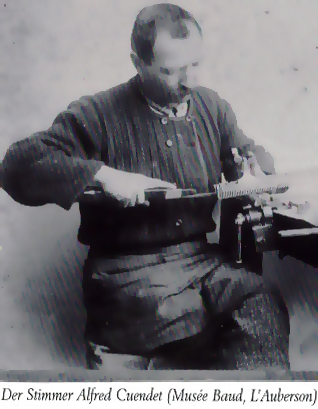

.jpg)

 logo.jpg)
 logo.jpg)

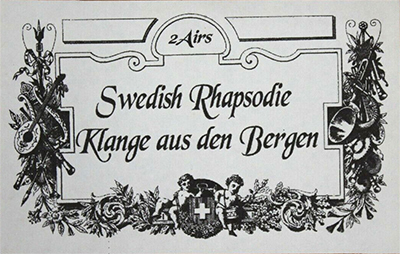
.jpg)

 - Kopie.jpg)

